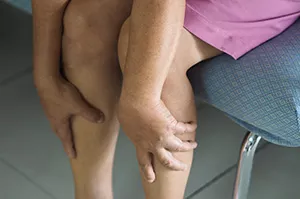
PAD or peripheral arterial disease is a progressive disorder that affects 20 million Americans (and greater than 200 million people worldwide). That’s more than cancer, stroke and congestive heart failure. Fortunately, there are treatments. We asked Raj P. Shah MD, MBA, a Vascular-Interventional Radiologist for Commonwealth Radiology Associates and Lowell General Hospital, a partner of Tufts Medical Center, about the signs and symptoms of this common disease.
What causes PAD?
PAD is a circulatory problem- plaque build-up results in narrowed or blocked arteries, reducing blood flow to the extremities (most commonly, the legs and feet).
PAD is common, affecting millions of individuals worldwide; it has a prevalence of 29% in high-risk individuals (greater than age 70 without additional risk factors OR 50 to 69-year-old individuals with a history of smoking or diabetes).
Facts:
1 in 20 Americans over the age of 50 have PAD. 20 million Americans suffer from PAD Individuals with PAD and diabetes have a 5x greater risk of amputation.
How serious is PAD?
PAD is widespread and can be life-threatening. Unfortunately, PAD remains underdiagnosed and undertreated. Undiagnosed and untreated, PAD can result in severe leg pain, painful foot ulcers, infections and gangrene, which could lead to poor quality of life and even amputation.
Facts:
Every year, there are approximately 200,000 leg amputations in the United States, many of which can be avoided with proper treatment.
What are risk factors for PAD?
Common risk factors include smoking, diabetes, high blood pressure, high cholesterol, kidney disease, obesity, aging and family history.
Facts:
Smoking increases risk for PAD by several-fold; approximately 90% of patients with PAD have a history of smoking. 1 in 3 persons over the age of 50 with diabetes is likely to have PAD.
What are the symptoms of PAD?
Symptoms of PAD include leg pain, cramping, tingling, numbness, cold feet, poor hair/nail growth, non-healing ulcers or gangrene. PAD symptoms can often be difficult to recognize as a sign of a more serious health problem. PAD symptoms are often treatable. Early detection is important; seeking guidance and treatment from a vascular specialist can lead to symptomatic relief and may prevent/delay disease progression. Schedule an appointment today.
How is PAD diagnosed?
If you have any of the above symptoms or risk factors, you should consult as soon as possible with your primary care physician, who might refer you to a vascular specialist for testing. The most common test for PAD is the “ankle-brachial index,” which compares the blood pressure in the ankle with that in the arm. Other diagnostic imaging includes ultrasound scanning, CT scans, MRIs (which don’t involve X-rays) and angiography (X-rays combined with the injection of a contrast agent).
How is PAD treated?
Non-surgical treatments include smoking cessation, supervised exercise programs, diet modifications and medication. If these interventions aren’t sufficient, minimally invasive procedures are effective, with no incisions and quick recovery, include angioplasty and stenting (to unblock or repair blood vessels). More advanced cases of PAD may require a surgeon to perform open surgery in the form of lower extremity revascularization (bypass surgery) or endarterectomy (the removal of the inner lining of an artery). Every patient is unique and treatment plans must be customized. We utilize advanced minimally invasive techniques and cutting-edge technology to give patients the best chance at limb salvage and amputation prevention.
About Raj P. Shah, MD
Dr. Raj P. Shah is an American board-certified diagnostic and vascular/interventional radiologist. Dr. Shah trained at Miami Cardiac and Vascular Institute, a center of excellence in endovascular care. His philosophy and techniques are a culmination of his training and experience. He has a bachelor's degree in biomedical engineering from the University of Connecticut (graduating summa cum laude); he subsequently attended medical school at the University of Connecticut and completed his diagnostic radiology residency at Hartford Hospital. Dr. Shah brings superior clinical acumen and technical expertise to the Wellforce System, offering revolutionary procedures to patients here in the greater Boston area.